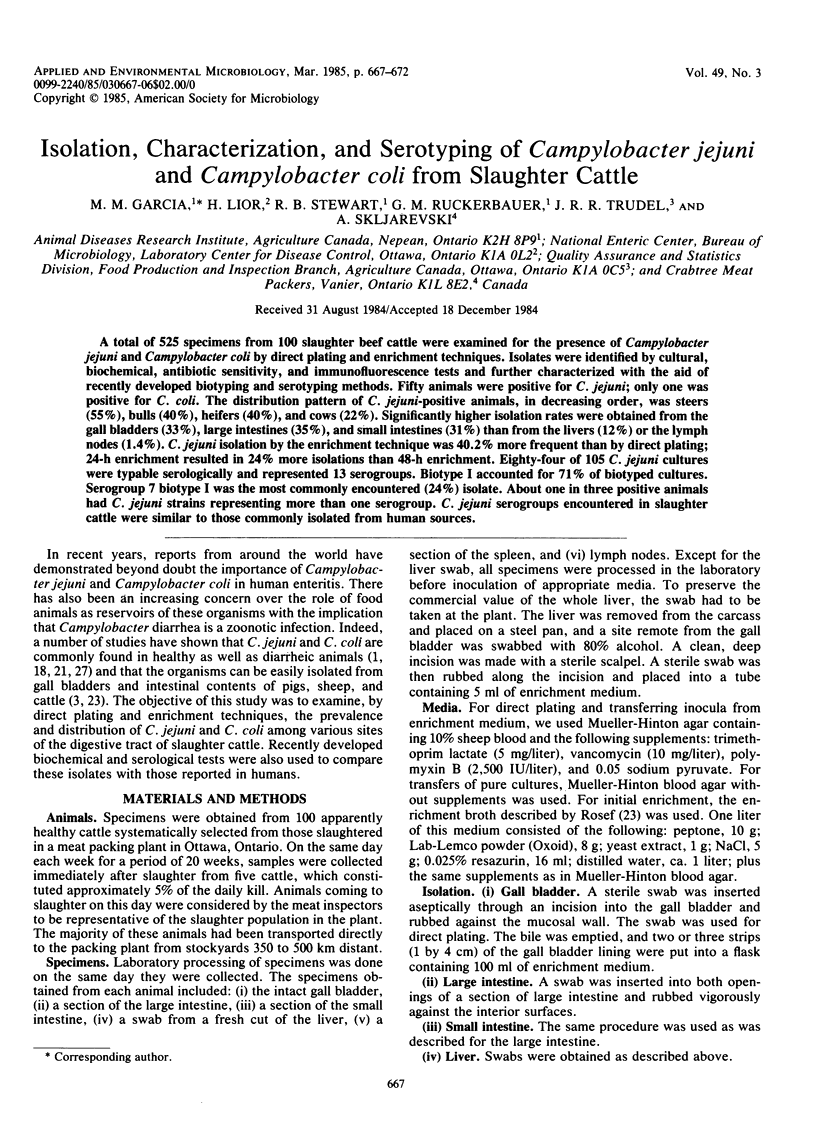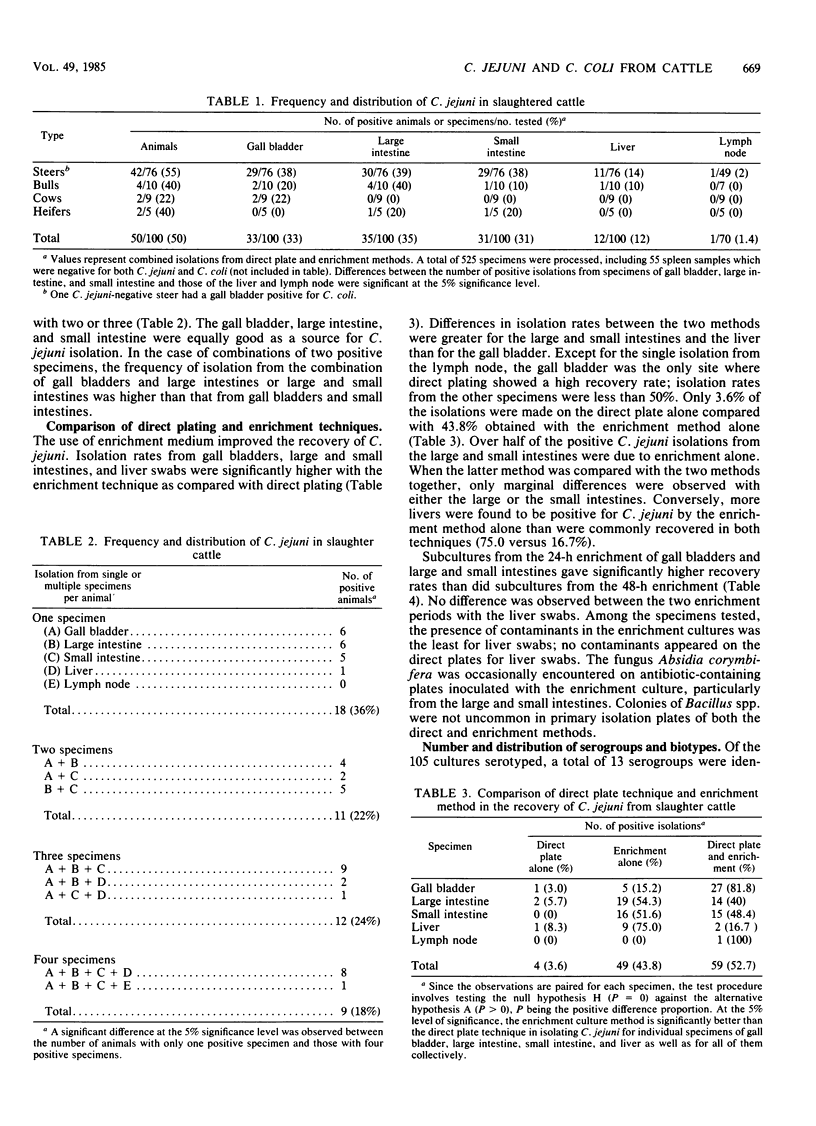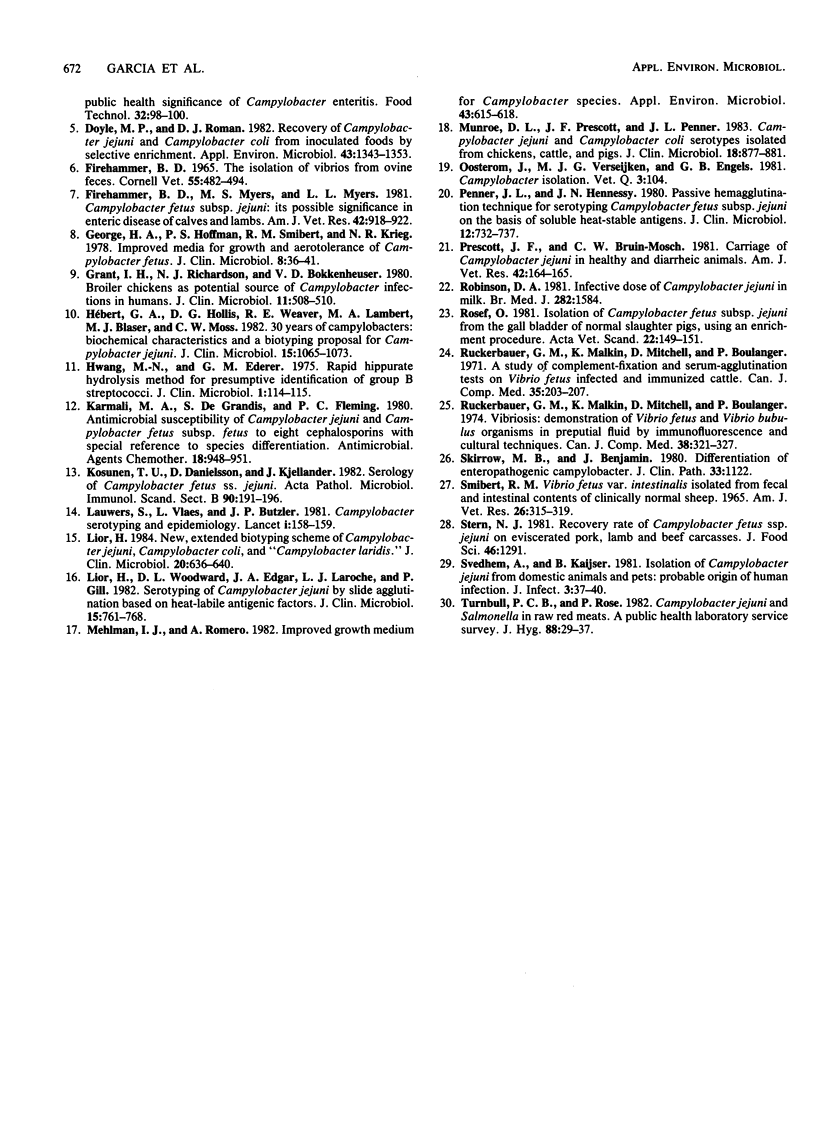Abstract
A total of 525 specimens from 100 slaughter beef cattle were examined for the presence of Campylobacter jejuni and Campylobacter coli by direct plating and enrichment techniques. Isolates were identified by cultural, biochemical, antibiotic sensitivity, and immunofluorescence tests and further characterized with the aid of recently developed biotyping and serotyping methods. Fifty animals were positive for C. jejuni; only one was positive for C. coli. The distribution pattern of C. jejuni-positive animals, in decreasing order, was steers (55%), bulls (40%), heifers (40%), and cows (22%). Significantly higher isolation rates were obtained from the gall bladders (33%), large intestines (35%), and small intestines (31%) than from the livers (12%) or the lymph nodes (1.4%). C. jejuni isolation by the enrichment technique was 40.2% more frequent than by direct plating; 24-h enrichment resulted in 24% more isolations than 48-h enrichment. Eighty-four of 105 C. jejuni cultures were typable serologically and represented 13 serogroups. Biotype I accounted for 71% of biotyped cultures. Serogroup 7 biotype I was the most commonly encountered (24%) isolate. About one in three positive animals had C. jejuni strains representing more than one serogroup. C. jejuni serogroups encountered in slaughter cattle were similar to those commonly isolated from human sources.
Full text
PDF





Selected References
These references are in PubMed. This may not be the complete list of references from this article.
- Blaser M. J., LaForce F. M., Wilson N. A., Wang W. L. Reservoirs for human campylobacteriosis. J Infect Dis. 1980 May;141(5):665–669. doi: 10.1093/infdis/141.5.665. [DOI] [PubMed] [Google Scholar]
- Bolton F. J., Robertson L. A selective medium for isolating Campylobacter jejuni/coli. J Clin Pathol. 1982 Apr;35(4):462–467. doi: 10.1136/jcp.35.4.462. [DOI] [PMC free article] [PubMed] [Google Scholar]
- Bryner J. H., O'Berry P. A., Estes P. C., Foley J. W. Studies of vibrios from gallbladder of market sheep and cattle. Am J Vet Res. 1972 Jul;33(7):1439–1444. [PubMed] [Google Scholar]
- Doyle M. P., Roman D. J. Recovery of Campylobacter jejuni and Campylobacter coli from inoculated foods by selective enrichment. Appl Environ Microbiol. 1982 Jun;43(6):1343–1353. doi: 10.1128/aem.43.6.1343-1353.1982. [DOI] [PMC free article] [PubMed] [Google Scholar]
- FIREHAMMER B. D. THE ISOLATION OF VIBRIOS FROM OVINE FECES. Cornell Vet. 1965 Jul;55:482–494. [PubMed] [Google Scholar]
- Firehammer B. D., Myers L. L. Campylobacter fetus subsp jejuni: its possible significance in enteric disease of calves and lambs. Am J Vet Res. 1981 Jun;42(6):918–922. [PubMed] [Google Scholar]
- George H. A., Hoffman P. S., Smibert R. M., Krieg N. R. Improved media for growth and aerotolerance of Campylobacter fetus. J Clin Microbiol. 1978 Jul;8(1):36–41. doi: 10.1128/jcm.8.1.36-41.1978. [DOI] [PMC free article] [PubMed] [Google Scholar]
- Grant I. H., Richardson N. J., Bokkenheuser V. D. Broiler chickens as potential source of Campylobacter infections in humans. J Clin Microbiol. 1980 May;11(5):508–510. doi: 10.1128/jcm.11.5.508-510.1980. [DOI] [PMC free article] [PubMed] [Google Scholar]
- Hwang M. N., Ederer G. M. Rapid hippurate hydrolysis method for presumptive identification of group B streptococci. J Clin Microbiol. 1975 Jan;1(1):114–115. doi: 10.1128/jcm.1.1.114-115.1975. [DOI] [PMC free article] [PubMed] [Google Scholar]
- Hébert G. A., Hollis D. G., Weaver R. E., Lambert M. A., Blaser M. J., Moss C. W. 30 years of campylobacters: biochemical characteristics and a biotyping proposal for Campylobacter jejuni. J Clin Microbiol. 1982 Jun;15(6):1065–1073. doi: 10.1128/jcm.15.6.1065-1073.1982. [DOI] [PMC free article] [PubMed] [Google Scholar]
- Karmali M. A., De Grandis S., Fleming P. C. Antimicrobial susceptibility of Campylobacter jejuni and Campylobacter fetus subsp. fetus to eight cephalosporins with special reference to species differentiation. Antimicrob Agents Chemother. 1980 Dec;18(6):948–951. doi: 10.1128/aac.18.6.948. [DOI] [PMC free article] [PubMed] [Google Scholar]
- Kosunen T. U., Danielsson D., Kjellander J. Serology of Campylobacter fetus ss. jejuni. 2 Serotyping of live bacteria by slide, latex and co-agglutination tests. Acta Pathol Microbiol Immunol Scand B. 1982 Jun;90(3):191–196. [PubMed] [Google Scholar]
- Lauwers S., Vlaes L., Butzler J. P. Campylobacter serotyping a epidemiology. Lancet. 1981 Jan 17;1(8212):158–159. doi: 10.1016/s0140-6736(81)90748-0. [DOI] [PubMed] [Google Scholar]
- Lior H. New, extended biotyping scheme for Campylobacter jejuni, Campylobacter coli, and "Campylobacter laridis". J Clin Microbiol. 1984 Oct;20(4):636–640. doi: 10.1128/jcm.20.4.636-640.1984. [DOI] [PMC free article] [PubMed] [Google Scholar]
- Lior H., Woodward D. L., Edgar J. A., Laroche L. J., Gill P. Serotyping of Campylobacter jejuni by slide agglutination based on heat-labile antigenic factors. J Clin Microbiol. 1982 May;15(5):761–768. doi: 10.1128/jcm.15.5.761-768.1982. [DOI] [PMC free article] [PubMed] [Google Scholar]
- Mehlman I. J., Romero A. Improved growth medium for Campylobacter species. Appl Environ Microbiol. 1982 Mar;43(3):615–618. doi: 10.1128/aem.43.3.615-618.1982. [DOI] [PMC free article] [PubMed] [Google Scholar]
- Munroe D. L., Prescott J. F., Penner J. L. Campylobacter jejuni and Campylobacter coli serotypes isolated from chickens, cattle, and pigs. J Clin Microbiol. 1983 Oct;18(4):877–881. doi: 10.1128/jcm.18.4.877-881.1983. [DOI] [PMC free article] [PubMed] [Google Scholar]
- Oosterom J., Vereijken M. J., Engels G. B. Campylobacter isolation. Vet Q. 1981 Apr;3(2):104–104. doi: 10.1080/01652176.1981.9693807. [DOI] [PubMed] [Google Scholar]
- Penner J. L., Hennessy J. N. Passive hemagglutination technique for serotyping Campylobacter fetus subsp. jejuni on the basis of soluble heat-stable antigens. J Clin Microbiol. 1980 Dec;12(6):732–737. doi: 10.1128/jcm.12.6.732-737.1980. [DOI] [PMC free article] [PubMed] [Google Scholar]
- Prescott J. F., Bruin-Mosch C. W. Carriage of Campylobacter jejuni in healthy and diarrheic animals. Am J Vet Res. 1981 Jan;42(1):164–165. [PubMed] [Google Scholar]
- Robinson D. A. Infective dose of Campylobacter jejuni in milk. Br Med J (Clin Res Ed) 1981 May 16;282(6276):1584–1584. doi: 10.1136/bmj.282.6276.1584. [DOI] [PMC free article] [PubMed] [Google Scholar]
- Rosef O. Isolation of Campylobacter fetus subsp. jejuni from the gallbladder of normal slaughter pigs, using an enrichment procedure. Acta Vet Scand. 1981;22(1):149–151. doi: 10.1186/BF03547219. [DOI] [PMC free article] [PubMed] [Google Scholar]
- Ruckerbauer G. M., Malkin K., Mitchell D., Boulanger P. A study of complement-fixation and serum agglutination tests on vibrio fetus infected and immunized cattle. Can J Comp Med. 1971 Jul;35(3):203–207. [PMC free article] [PubMed] [Google Scholar]
- Ruckerbauer G. M., Malkin K., Mitchell D., Boulanger P. Vibriosis: demonstration of Vibrio fetus and Vibrio bubulus organisms in preputial fluid by immunofluorescence and cultural techniques. Can J Comp Med. 1974 Jul;38(3):321–327. [PMC free article] [PubMed] [Google Scholar]
- Skirrow M. B., Benjamin J. Differentiation of enteropathogenic Campylobacter. J Clin Pathol. 1980 Nov;33(11):1122–1122. doi: 10.1136/jcp.33.11.1122. [DOI] [PMC free article] [PubMed] [Google Scholar]
- Svedhem A., Kaijser B. Isolation of Campylobacter jejuni from domestic animals and pets: probable origin of human infection. J Infect. 1981 Mar;3(1):37–40. doi: 10.1016/s0163-4453(81)92261-1. [DOI] [PubMed] [Google Scholar]


